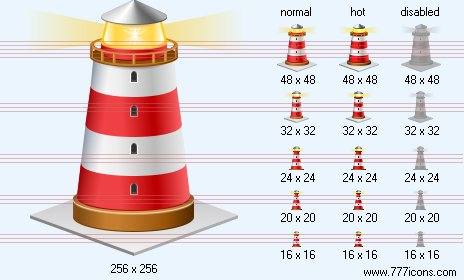


|
| ||||||||
|
|
Lighthouse Icon |
|
Image sizes: 256x256, 128x128, 64x64, 48x48, 32x32, 24x24, 20x20, 16x16
File formats: BMP, GIF, PNG, ICO
Picking The Right Image Format When Making Graphics.
There are several image formats that can be put to use for storing icons and for a newbie website maker this can often turn into a major issue because you will need to understand how to use a certain image format, given below is a take on the advantages and issues of some commonly used file formats.If you are interested in icon making or want to create icons for your web site, it is essential to learn about the different image formats and their traits so that you can utilize the appropriate file format for graphics. Normally used file formats for graphics are JPEG, PNG and GIF, every one these formats has its own traits so lets discuss the benefits and drawbacks of using these file formats, the type of image format that should suit your web page and optimizing your images for the web usage.
GIF: It is the abbreviation for Graphics Interchange Format; the format is one of the most commonly used file types. The reason for its popularity is its image size that is very small which makes uploading less time consuming. Unlike JPEG, information is not lost in this file type which means you will be able to save the file in a smaller size without deteriorating the quality of the images. The format is also known to support transparency in graphics, it is one of the most commonly used file formats for web graphic designing. Unlike the other formats, animation is also possible in GIF. If you would like to go for GIF file optimization, it is vital to limit the file size; it would be best that you choose a 32 color palette to create a suitably small size.
JPEG: This is the abbreviation for Joint Photographic Experts Group; the file type is usually called JPG and is usually incorporated on websites. One of the primary advantages of incorporating this type of image is that you can store the graphics in true color that gives you an impressive range of 16 million colors; making this file type suitable for storing photos and images that boast of detailed color range. One of the problems of utilizing JPG is the information loss that will have to be tackled each time the file is saved; this equates to the fact that the picture is prone to compromised clarity and a lot of details may be lost. Unlike GIF, support for transparency is not provided in this format. If you are using a superior image editing software such as the Adobe Photoshop, you will be able to select the image quality and the size of the JPG file but it is important to comprehend that the lower the resolution the smaller the size, which is simple to upload.
PNG: Is an abbreviation for Portable Network Graphics and is a fairly fresh image format. This format is offered in two forms; PNG-8 which has a 8 bit color format and the PNG-24 which offers 24 color graphics. PNG-8 can compress images with fantastic detail and without the customary loss of information seen in the GIf format; this leads to improved image quality and fast uploads. But, PNG-24 is not as effective as JPG when you need to store pictures and other images that merit the use of a wider color palette. The file type is not limited by loss; this means that the image holds on to its quality and clarity. PNG-24 supports transparency and you can use various levels of of the feature in this image type. When you use this file format the pictures are professional looking because they do not have the jagged edges when placed in relation to a contrasting color backgrounds like GIF files.
Copyright © 2006-2022 Aha-Soft. All rights reserved.
|

